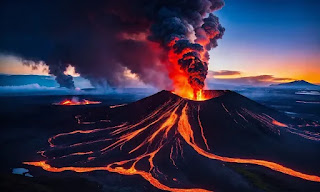The Nazca Ridge is a prominent underwater feature that stretches across the southeastern Pacific Ocean, extending from the Nazca Plate towards the Peru-Chile Trench along the western coast of South America. This ridge is a key player in the tectonic and seismic activities of the region, with far-reaching effects on geology, marine ecosystems, and human culture.
Location and Overview
The Nazca Ridge extends for nearly 1,100 km, beginning in the ocean basin and reaching toward the coastline of Peru. It is part of the broader Nazca Plate, a section of the Earth's lithosphere that is in constant motion due to tectonic forces. The ridge itself is composed of extinct volcanic seamounts formed millions of years ago, as the Nazca Plate passed over a hotspot, an upwelling of molten rock from deep within the Earth’s mantle.
Geological Formation
The formation of the Nazca Ridge is linked to volcanic hotspot activity beneath the ocean floor. As the Nazca Plate drifted over the hotspot, magma erupted from beneath the Earth's crust, creating a series of underwater volcanoes. Over time, these volcanoes cooled and formed seamounts, which collectively make up the Nazca Ridge. This process occurred during the Cenozoic Era, approximately 40-50 million years ago.
- Age and Evolution: The exact age of the Nazca Ridge seamounts varies, with the oldest parts being further to the west. Studies suggest that the volcanic activity associated with the ridge ceased around 30 million years ago.
- Submarine Topography: The ridge stands several kilometers above the surrounding ocean floor, rising to heights of up to 1,500 meters beneath the ocean surface.
Hawaii
Interaction with the Peru-Chile Trench
The Peru-Chile Trench (or Atacama Trench) is a major geological feature where the Nazca Plate is being forced beneath the South American Plate in a process called subduction. This tectonic process results in significant geological deformation, contributing to the rugged landscape of the Andes Mountains and influencing seismic activity in the region.
- Subduction Effects: As the Nazca Ridge is subducted, its relatively high elevation compared to the surrounding oceanic crust causes it to act like a "bulldozer," altering the subduction dynamics. This can influence the angle of subduction and the overall tectonic behavior of the region.
- Andes Uplift: The interaction between the ridge and the Peru-Chile Trench leads to the uplift of the Andes Mountains, which continues to grow even today due to ongoing tectonic forces.
Andes Mountains
Seismic and Tectonic Significance
The seismic activity associated with the subduction of the Nazca Ridge is profound. The region is part of the Pacific Ring of Fire, which is known for some of the world’s most powerful earthquakes and volcanic eruptions.
- Earthquake Activity: The subduction of the Nazca Ridge has led to a series of megathrust earthquakes, with magnitudes often exceeding 8.0 on the Richter scale. One of the largest earthquakes recorded in the region was the 1960 Valdivia earthquake in Chile, which measured 9.5, the largest earthquake ever recorded.
- Seismic Gaps: Interestingly, areas where the Nazca Ridge is being subducted often show reduced volcanic activity, forming what are known as volcanic gaps. These regions still experience significant seismic activity, but with fewer volcanic eruptions due to the ridge’s influence on subduction angles.
Ecological Importance
The unique topography of the Nazca Ridge has a profound impact on ocean currents and marine ecosystems. The ridge acts as a natural barrier, influencing upwelling patterns that bring nutrient-rich waters to the surface, supporting a diverse array of marine life.
- Marine Biodiversity: The ridge is home to an abundance of marine species, including sharks, whales, and deep-sea fish. The area is part of the Humboldt Current System, one of the most productive marine ecosystems in the world. The cold, nutrient-rich waters support extensive fisheries, including those for anchovies, sardines, and other commercially valuable species.
- Endangered Species: Some regions around the ridge are recognized as habitats for endangered species like the green sea turtle and blue whale, making conservation efforts critical for maintaining biodiversity.
Scientific Research and Exploration
The Nazca Ridge is a focal point for geological and marine research. Scientists are keen to understand how plate tectonics and volcanic activity shape the ocean floor and how these forces interact with ecosystems.
- Seafloor Mapping: Researchers have used seismic tomography and remote sensing to map the structure of the Nazca Ridge and study its subduction beneath South America. These studies are essential for understanding the earthquake potential of the region.
- Plate Tectonics: The Nazca Ridge offers insights into the broader processes of continental drift and mantle dynamics, helping to explain how Earth's tectonic plates move and interact over time.
Nazca Lines
Cultural and Historical Relevance
The Nazca Ridge is geographically linked to the Nazca region of Peru, known for the Nazca Lines, which were created between 100 BCE and 800 CE by the ancient Nazca culture. The relationship between these cultural wonders and the geological significance of the ridge adds a layer of intrigue to the region's history.
- Speculative Connections: While there is no direct geological connection, some researchers have suggested that the Nazca people's knowledge of natural forces, including earthquakes, might have influenced their creation of the Nazca Lines, which are thought to have had religious or astronomical significance.
Conclusion
The Nazca Ridge stands as a testament to the dynamic processes that shape our planet. From its role in the subduction of the Nazca Plate and the formation of the Andes Mountains to its influence on marine ecosystems and seismic hazards, the ridge offers a window into the ongoing geological forces that drive Earth’s evolution. As scientists continue to study its complexities, the Nazca Ridge remains a symbol of both scientific curiosity and natural wonder.





